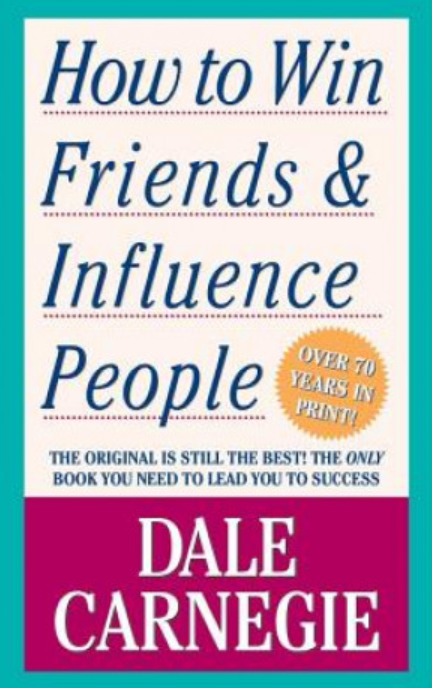There aren’t too many people that haven’t heard the name “Dale Carnegie”. Carnegie and his courses are still offered and taught today, much after his name rose to success with the successful release of his 1936 best-seller, How to Win Friends and Influence People. Carnegie’s book is recognized by most as the only book you need to improve your leadership and communication with others.
How to Win Friends and Influence People Summary
How to Win Friends and Influence People is a complete guide to one of our innermost desires: The need for friends and the need to win people over to our way of thinking and having them help you achieve your goals. No person is an island, and everyone needs people, outside of their family that agree with their ideals and are willing to join them in life’s struggles. The book is broken down into four parts:
- 1. Fundamental Techniques in Handling People
- Six Ways to Make People Like You
- How to Win Others to Your Way of Thinking
- Being a Good Leader.
Although summarizing this great read is a difficult task, we will endeavor to do so below and give each section the recognition it deserves
Best ideas from How to Win Friends and Influence People

Fundamental Techniques in Handling People
Despite being the shortest of the sections, it is by no means the least important. The first section sets up the fundamental building blocks of learning and relearning how to approach others. The most basic truth when starting to speak with someone is to first try and understand where someone is coming from, in their thoughts, feelings, and prejudices before trying to be understood. There are three fundamental techniques in this chapter which are:
- Don’t criticize, condemn or complain
- Give honest and sincere appreciation
- Arouse in the other person an eager want
Although many of these techniques will seem obvious when we are reading them, you will realize that the way we THINK we act and the way we ACT are completely different. We are not logical people, we are mostly dealing with creatures that feel, have ambition, and have pre-conceived notions of how the world should be. In this way, we should not criticize anyone openly and upon meeting, or else they will immediately be turned off. Through active listening, we can give unique and honest appreciation for things that they believe are true. Finally, and most importantly, using their own language to inspire them to want something, such as the want to get to know you better, or to see if this is a good relationship.
Six Ways to Make People Like You
- Become genuinely interested in other people
- Smile
- The other person’s name is the sweetest and most important sound to them
- Being a good and active listener
- Speak in the other person’s language and interests
- Make them feel important, and do so sincerely
This part needs no introduction, Carnegie literally LISTS six ways to make people like you, and goes into further detail. In order to become genuinely interested in others, the key trick is to find out why it makes them so passionate and to then form your own opinion about it.
If someone mentions they like to collect bugs, for example, instead of taking it as an interesting fact and moving on, you could ask further questions such as “What makes you passionate about this?” What are some great experiences you’ve had when out collecting?” and many more.
Remembering to smile seems like simple advice, but most of us don’t do it outside polite conversation or something that is funny. Smiling, agreeing, and probing further with someone’s interests is further compounded by a big and genuine smile.
When introducing yourself, the other person will, most of the time, follow suit. While most of us will keep speaking to that person and confirm their name, Carnegie’s advice is a breakthrough. Imagine yourself talking to someone and they, from time to time, say such things as “John Smith, what do you think about x?” “John that sounds like a great idea” and “It was a pleasure speaking to you, John Smith”. It elicits feelings of importance and recognition.
Listen, and be a good listener. Pick up nuances. Ask questions, probe further and follow up on things you don’t understand rather than agreeing and going past it.
The last two points can be grouped together, When we mimic the other person’s speech, thought and movement patterns, they automatically are pre-disposed to think better of us. Imitation is a survival instinct we have from our first days on planet earth, and it still an extremely powerful tool. If you find out what motivates the other person, and in what manner, you can speak to them through those incentives and praise them for their place in the world.
How to Win Others to Your Way of Thinking and Being a Good Leader
Carnegie separates these sections, and does so for a good reason, but for the purposes of this review, one ties in with the other. When you have mastered the fundamentals of understanding what makes people tick, their interests, values, prejudices and recognition, you can start winning them over and leading them properly. For example, one of the key points in part 3, “Let the person feel that the idea is theirs” leads to a key point in part 4 “Give the other person a fine reputation to live up to”.
Combining such tools as praise, appreciation and avoiding arguments with others; believing that the successful idea is theirs, will encourage them to take ownership. You can then ask them to set deadlines and expectations to get it done. Always be there to praise, support and mentor if needed.
How to Win Friends and Influence People: The Good, The Bad, and Should You Read it?
Some critics of How to Win Friends and Influence People speak against the book, saying it is a guide for manipulation. Dale Carnegie received praise for his leadership style and many workers that were being led were happy that they had a confident manager that read the book. The motives of some are their own, and if they are insincerely trying to manipulate someone, it will not work with these principles.
How to Win Friends and Influence People is at its essence a book about communication, not manipulation or bending people’s will. Everyone should read this book of all ages to develop clear communication and understanding of how others’ opinions and lifestyles affect the way they act and feel.
Everyone is fighting an unseen battle and deserves respect, even those you don’t know. The book can be summarized with one Carnegie quote: “Be hearty in your approbation, and lavish in your praise”. Happy reading.

